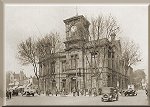|
|
 |

Click to return to front page |
By Frank Sharman
For what we can get from place names we turn to
David Horowitz’s “Place Names of Staffordshire” (2006).
“Bilston” means “the dwellers at Bil”. The
name comes from the Old English saetna meaning “of the
settlers” (and the “ton” element is not, as the earliest versions of
the name show, the Old English word ton, meaning “settlement”
as in Wolverhampton). “Bil” may be a contraction of a personal
name; or it may have been the name of a nearby hill ,since the Old
English bile has that meaning, though not often in place
names. Those possible derivations of the name may be less
dramatic than that speculated on by Lawley and other local writers
but are certainly more accurate.
But David Bennett suggests that: "Maybe the 'Bil' part is, after
all, a reference to a hill - a prominent one too - Sedgley Beacon.
Peel back the urban area to the original landscape and the Beacon
would have been a significant feature. 'The place at or near
the 'Bil'' is not impossible a meaning.
30 years ago I would not
have subscribed to this suggestion, as the Beacon never seemed that
prominent to me as I grew up in Bilston in the 1960s and 70s.
However, after the demolition of the steel works in the early 1980s,
the uninterrupted view from Bilston to the Beacon was revealed. The
Beacon is still very noticeable today, especially if you ignore the
modern accretions in between". Bearing in mind that early place
names often reflect local geographical features, this suggestion
certainly holds attractions
“Bradley” means “the broad clearing in woodland”. The name comes from the Old English brad, meaning “broad” and the Old English leah, which means either a wood in an open area or a clearing in woodland, according to context. In this case it must have the latter meaning. It is one of many “–leys” in the area, indicating not only the exploitation of natural clearings but the creation of new clearings.
“Ettingshall” means either “the grazing place” or “the place of Etting”. There is no personal name “Etting” otherwise recorded and it is more likely that this element of the name comes from the Old English etting, which means a pasturage or grazing place. “Hall” derives from the Old English halh which simply means “a place” and is not an indication of a hall or other building.
The name of the district “The Lunt” comes from the Old Norse word lundr which means a grove or a copse, even “a sacred grove”. This reflects the open woodland nature of the area (but perhaps should not be taken as an indication of Norse settlement in the area).
“Ladymoor” is a somewhat more recent name as it seems to be medieval. It is said to mean “the moorland dedicated to the Virgin Mary” but the possibility that it means “the moorland owned by the lady of the manor” cannot be excluded. In either case the type of the land in this area is indicated.
The nature of these names, and of other names in the area generally, indicate that there was widely dispersed settlement in a wooded area that was gradually being turned into farmland. The presence of some moorland reminds us by that the area contained both good agricultural land (if not the best) and at least some land that was not fit for the plough.
Bilston first appears in the written record at the end of the 10th century when, in 985 AD land was given by King Aethelred to Lady Wufrun; and when she, in turn, gave some of that land to found (or, possibly, re-found) a monastery at Wolverhampton. The land granted included “Bilsetnatum”.
 |
 |
| Back to Introduction | After The Conquest |